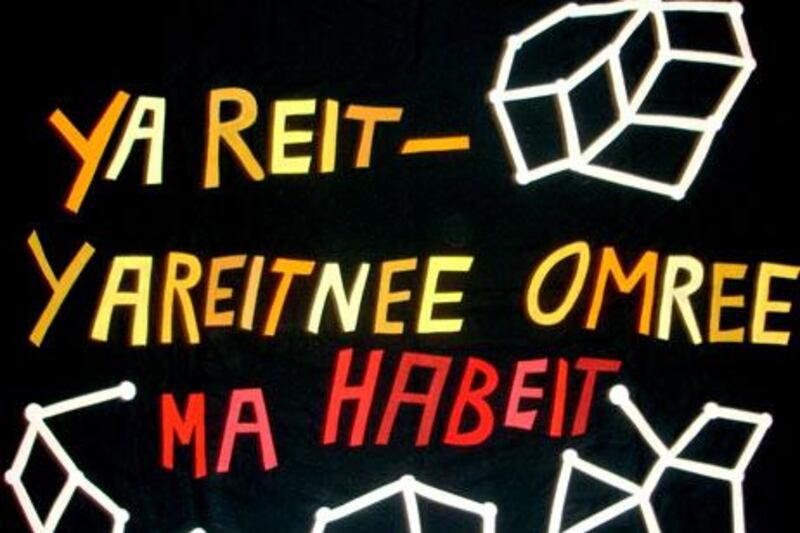Two galleries, one curator and 31 artists. Intersperse the likes of Banksy and Tracey Emin with the leading lights of the Middle East’s art scene and Rami Farook’s latest curatorial highjinks match up to his ambitious trademark.
Art: The National looks
Exhibitions, reviews, news, features and all things art
[ Art ]
The State: Social/Antisocial? is a link-up between Farook's Traffic gallery and The Third Line, both spaces in the Al Quoz district of Dubai. It's the third time the gallerist has done one of these broad investigations into "social behaviour, ecology and psychology", with emphasis on "the state of the world today". As a line of inquiry it's grand, and a big burden to carry across all that floor space.
Farook has enlisted confrontational voices to hammer the point home. It stays coherent, to an extent, but it’s a show that’s combusting on all angles. There are flashing neon, LEDs by the bucketload, exposed circuitry, enigmatic figures throwing themselves into a great unknown and the long shadow of Osama bin Laden fading in and out like an aside.
The Third Line outing is the more focused of the two. With free rein of the gallery’s illustrious stable, Farook has packed the space out: from drawings by Laleh Khorramian – doodled black scenes that are epic and inscrutable – to a Hassan Hajjaj photograph of a smiling Moroccan man leaning against a background of brilliant blue. There’s a tapestry by Susan Hefuna, Youssef Nabil’s hand-coloured portrait photographs of Shirin Neshat and Catherine Deneuve, art in stairwells and corridors. Very little wall is left naked.
With his arsenal of artists, Farook seems to be saying that in times of crisis, the world leans hard on its ideas of utopia. Be it a utopia of staring up to the heavens and wishing to recreate that on earth by whatever means possible, or the utopian yearnings of a revolution – represented here in a work by Huda Lutfi that shows the heads of women snapped on the streets of Cairo transplanted on to the bodies of Egyptian military personnel.
Then there’s the utopia of the state, or the police state specifically. The Dubai-based artist James Clar has meticulously recreated a lamppost from Tiananmen Square, its ornate base rising to a metal stalk festooned with surveillance cameras. It’s a reminder that the seemingly benevolent apparatus of the state often leads to control.
This finely wrought thread played out in the first half starts to fray once The State hits Traffic. Unevenness from one piece to the next does take something away from these shows. For instance, a deeply moving work at The Third Line by Joana Hadjithomas and Khalil Joreige, a video piece in which former Lebanese detainees of the Khiam prison camp set up by Israel in south Lebanon relate their experiences with surprising matter-of-factness and lucidity, is in the same exhibition as a Where's Wally book in which the bespectacled hero has had a black polygon slapped on him to represent a chador. Said item, Where's Waheeda by the Dubai-based Ubik, is one of a number of works that come off frivolous, even slightly arrogant, in their literalness alongside grave and resonant pieces. The same goes for the inclusion of towering western giants such as Banksy and Damien Hirst – Hirst's Fun is an assemblage of pills and a half-full syringe. Neither contributes much to an otherwise relevant discussion.
Consequently, The State feels overwhelmed with work. A bit less on the walls would certainly make getting your head around it easier.
It is impossible to comment sufficiently on everything, but there are highlights in Traffic that make part two worth seeing. The floor plan of Bin Laden’s OK corral in Pakistan, laid out in LEDs by Clar, is an excellent work. There’s also the Saudi artist/doctor Ahmed Mater’s finest work – a collection of CCTV screens showing the constant, bubbling intensity that underpins life in a hospital. Look out as well for Aman Mojadidi’s imaginary love letters to an anonymous recipient in Kabul. Each letter, penned by the artist, is laced through with sentimental language and security feeds from the frontline of US intelligence.
The State is big and hard to fathom as a whole. But the scale of its ambition has to be commended. This is a full day out of contemporary art, from both East and West, and it's a very personal show for Farook.
But hoping to carry a grandiose narrative about the state of the world across two galleries and four big white rooms – well, even a museum would struggle with that.
The State: Social/Antisocial? ends on October 20 at The Third Line gallery in Dubai, but continues at Traffic until October 27. Visit www.viatraffic.org for details.
Follow us on Twitter and keep up to date with the latest in arts and lifestyle news at twitter.com/LifeNationalUAE










